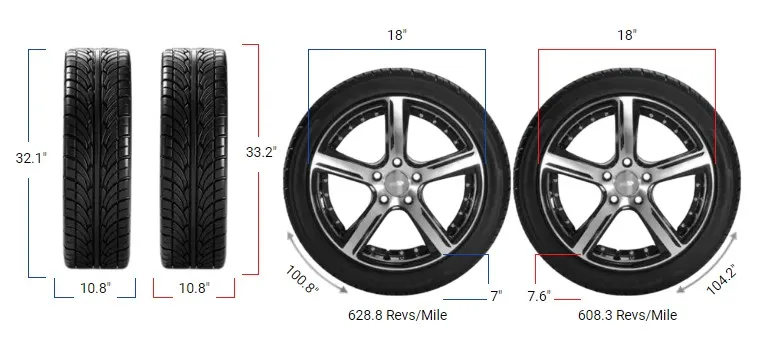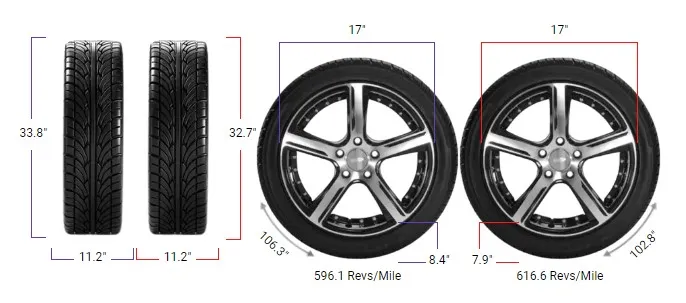Tire Size 265/70r17 vs 265/65r17

Are you considering switching from 265/70R17 to 265/65R17 tires? While these tire sizes may seem similar, there are some important differences to consider before making the change.
- Switching to 265/65R17 tires is not recommended without necessary adaptations
- The shorter sidewall of 265/65R17 tires may result in a slightly firmer ride
- Improved handling and responsiveness can be expected with 265/65R17 tires
- The speedometer may read slightly higher than actual speed with 265/65R17 tires
- Fuel efficiency may slightly improve due to lower rolling resistance of 265/65R17 tires
- Ground clearance will be reduced with 265/65R17 tires, impacting off-road performance

Fitment Guide
It’s important to note that the overall diameter difference between these sizes exceeds the acceptable 3% range. The 265/65R17 tires have a diameter that is 3.3% smaller than the 265/70R17 tires.
As a result, this interchange is not recommended without making necessary adaptations to prevent issues such as rubbing or clearance problems.
On-Road Impact
Switching from 265/70R17 to 265/65R17 tires can have a noticeable impact on your vehicle’s on-road performance. Let’s explore some of the key areas affected by this tire size change.
- Ride Comfort: The shorter sidewall of the 265/65R17 tires may result in a slightly firmer ride compared to the 265/70R17 tires. This is because the shorter sidewall provides less cushioning against road imperfections, translating into a more direct feel of the road surface.
- Handling: The reduced sidewall height of the 265/65R17 tires can lead to improved handling and responsiveness. The shorter sidewall allows for quicker steering input and reduces tire flex during cornering, resulting in a more agile and precise driving experience.
- Speedometer Accuracy: Due to the smaller overall diameter of the 265/65R17 tires, your vehicle’s speedometer may read slightly higher than your actual speed. At 20 mph (32.19 km/h), the speedometer will display 19.34 mph (31.12 km/h), a difference of 0.66 mph (1.07 km/h). Keep this in mind when monitoring your speed on the road.
- Fuel Efficiency: The shorter sidewall and reduced overall diameter of the 265/65R17 tires can lead to a slight improvement in fuel efficiency. The smaller tire size results in lower rolling resistance, which means your vehicle requires less energy to maintain its speed, potentially saving you money at the gas pump.

Off-Road Impact
If you frequently take your vehicle off-road, switching from 265/70R17 to 265/65R17 tires can have some implications for your off-road adventures. Here are a few key considerations.
- Ground Clearance: The shorter sidewall of the 265/65R17 tires will result in a reduction in ground clearance compared to the 265/70R17 tires. This may impact your vehicle’s ability to navigate over obstacles and uneven terrain without risking damage to the undercarriage.
- Traction: The shorter sidewall of the 265/65R17 tires may provide slightly less traction in loose or soft terrain compared to the taller sidewall of the 265/70R17 tires. The taller sidewall allows for more tire flex and conformity to the terrain, improving grip in challenging off-road conditions.
- Durability: When venturing off-road, the shorter sidewall of the 265/65R17 tires may be more susceptible to damage from rocks, roots, and other obstacles. The reduced sidewall height provides less cushioning and protection against impacts, so it’s important to be mindful of your surroundings and driving style when exploring rugged terrain.

What is the Difference Between 265/70R17 and 265/65R17?
The main difference between 265/70R17 and 265/65R17 tires is the sidewall height. The 265/65R17 tire has a sidewall height that is 0.52 inches (13.25 mm) shorter than the 265/70R17 tire, resulting in a 7.1% reduction.
This difference in sidewall height contributes to a 1.04 inch (26.5 mm) or 3.3% overall diameter difference between the two tire sizes.
Can I Use 265/65R17 Instead of 265/70R17?
It is not recommended to use 265/65R17 tires instead of 265/70R17 tires without making necessary adaptations.
The overall diameter difference between these two sizes exceeds the acceptable 3% range, which can lead to issues such as rubbing, clearance problems, and inaccurate speedometer readings.
If you still want to make the switch, it’s important to consult with a professional to ensure proper fitment and safety.
How Much Taller Is a 265/70R17 Tire Than a 265/65R17?
A 265/70R17 tire is approximately 1.04 inches (26.5 mm) taller than a 265/65R17 tire. This height difference is due to the 0.52 inch (13.25 mm) difference in sidewall height between the two tire sizes, which contributes to the overall diameter difference of 3.3%.
265/70r17 vs 265/65r17 Table
This table clearly shows the differences between the two tire sizes in various key aspects.
This table provides a comparison between the tire sizes 265/70R17 and 265/65R17, highlighting the differences in diameter, width, circumference, sidewall height, and revolutions per mile.
| Feature | 265/70R17 | 265/65R17 | Difference |
|---|---|---|---|
| Diameter inches (mm) | 31.61 (802.8) | 30.56 (776.3) | -1.04 (-26.5) -3.3% |
| Width inches (mm) | 10.43 (265) | 10.43 (265) | 0 (0) 0% |
| Circumference inches (mm) | 99.29 (2522.07) | 96.02 (2438.82) | -3.28 (-83.25) -3.3% |
| Sidewall Height inches (mm) | 7.3 (185.5) | 6.78 (172.25) | -0.52 (-13.25) -7.1% |
| Revolutions per mile (km) | 638.1 (396.5) | 659.89 (410.03) | 21.78 (13.53) +3.4% |
| Speedo Reading | 20 mph | 19.34 mph | -0.66 mph |
Our Observation
After analyzing the differences between 265/70R17 and 265/65R17 tires, we’ve concluded that switching to the smaller tire size can have both benefits and drawbacks.
On the road, the 265/65R17 tires offer improved handling and potentially better fuel efficiency, but at the cost of a slightly firmer ride and minor speedometer inaccuracy.
Off-road, the shorter sidewall may compromise ground clearance and traction in challenging conditions while also being more vulnerable to damage.
Ultimately, the decision to switch tire sizes depends on your specific driving needs and priorities. If you value on-road performance and are willing to make slight compromises in off-road capability, the 265/65R17 tires may be a suitable choice.
However, if you frequently tackle rugged terrain and prioritize off-road performance, sticking with the 265/70R17 tires may be the better option.



